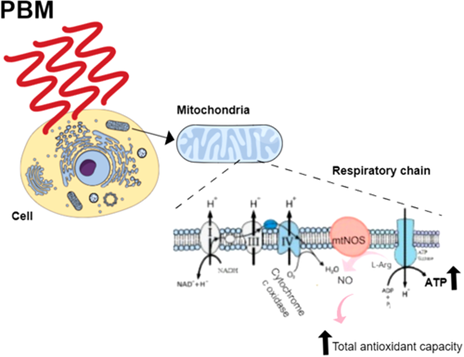The Single Strategy To Use For Photobiomodulation
Table of ContentsAbout PhotobiomodulationEverything about Photobiomodulation6 Simple Techniques For PhotobiomodulationSome Known Factual Statements About Photobiomodulation
Laser therapy is a clinical therapy that utilizes focused light to boost a procedure called. During PBM, photons go into the cells and communicate with the cytochrome c facility within mitochondria. This interaction sets off a biological waterfall of occasions that causes a boost in cellular metabolic rate, which can along with increase the healing procedure.There is agreement that the application of a healing dose of light to impaired or useless cells leads to a mobile feedback mediated by mitochondrial devices. Photobiomodulation. Research studies have shown that these modifications can impact pain and swelling, in addition to, tissue repair service
Changes in ATP, reactive oxygen species and nitric oxide follow light absorption by Cc, O. These effects are redox state and dose reliant.

The Definitive Guide to Photobiomodulation
PBM devices have actually been removed for advertising and marketing by FDA through the Premarket Notification/510( k) process as adjunctive tools for the temporary relief of discomfort. These clearances were based upon the discussion of clinical data to sustain such claims (Photobiomodulation). In this treatment, a source of light is put near or touching the skin, permitting the light power (photons) to pass through tissue where it interacts with chromophores found in cells resulting in photophysical and photochemical adjustments that bring about changes at the molecular, cellular and tissue degrees of the body
Remarkably, current study suggests that light can boost performance in normal tissues and cells. The potential applications of PBMT are countless and are being checked out experimentally at the fundamental scientific research, pre-clinical and scientific degree. The current scientific usages are for the alleviation of pain and swelling and the treatment of sporting activities injuries.

The treatment criteria and number of sessions needed for PBMT are reliant upon area and reason. PBMT generally requires more than one therapy for optimal pain alleviation.
How Photobiomodulation can Save You Time, Stress, and Money.
Treatment criteria for PBMT were initially developed utilizing cells in vitro and in little pet models. These treatment criteria generally had a low irradiance and fluence and functioned well for cutaneous applications. Nevertheless when clinicians started to make use of PBMT to deal with frameworks that lay deeper in the body, they made use of these parameters with unfavorable outcomes.
We now comprehend that these negative studies resulted from incorrect gadget and treatment specifications for transcutaneous therapy of much deeper structures. Current advances in laser treatment devices and even more research into the suitable dosages have significantly improved the results of PBMT. For treating deep cells, the wavelength of light used figures out the deepness of infiltration right into a cells.
It is essential that a medical professional utilizes the ideal wavelength of light and parameters to deal with a condition. One wavelength and one collection of treatment specifications will not be efficient for all conditions. Unfavorable side effects have not been reported from the usage of PBMT.
Photobiomodulation Fundamentals Explained
In the very first experiment, Dr. Endre Mester, utilized cut rats and observing how the laser influenced their ability to expand hair compared to the group that was not getting LLLT. He located that the team of mice getting LLLT had the click for info ability to expand their hair back more rapidly than the team of mice that didn't receive LLLT (Hoon C, et al; 2012).
This treatment is labelled this means to differentiate the difference between the lasers some professions use to cut (eg. Low-level light therapy is painless, non-invasive therapy.
LLLT has a biphasic response, implying that lower doses are usually attended be much more beneficial than greater doses. That view publisher site being said, dosages greater or lower than the optimal dosage doesn't influence (Hoon C, et al; 2012). For this reason, it can be difficult to have research studies on LLLT with a lot of parameters.
Some business incorporated both (LED and laser) to provide a more all-round treatment since lasers can penetrate much deeper than LED and infrared light (Norman Doidge, The Mind's Means of Healing, 2015). During therapy, the location that is being treated is revealed to LED light from a Bio, Flex Laser, which is at 660 nm wavelength, followed by infrared light at 830-840 nm wavelength.